In Vitro Rooting of Poplar: Effects and Metabolism of Dichlorprop Auxin Ester Prodrugs
Abstract
1. Introduction
2. Results
2.1. Root Induction Through Continuous Application of Auxin Analogs
2.1.1. DCP and DCPE
2.1.2. C77
2.2. Distribution of DCPE, DCP, and C77 and Their Metabolite DCP
2.2.1. DCP Metabolism over 8 Days
2.2.2. DCPE Metabolism over 8 Days
2.2.3. C77 Metabolism over 8 Days
3. Discussion
4. Materials and Methods
5. Conclusions
Supplementary Materials
Author Contributions
Funding
Data Availability Statement
Conflicts of Interest
References
- Friml, J. Fourteen stations of auxin. Cold Spring Harb. Perspect. Biol. 2022, 14, a039859. [Google Scholar] [CrossRef]
- Sabatini, S.; Beis, D.; Wolkenfelt, H.; Murfett, J.; Guilfoyle, T.; Malamy, J.; Benfey, P.; Leyser, O.; Bechtold, N.; Weisbeek, P.; et al. An auxin-dependent distal organizer of pattern and polarity in the Arabidopsis root. Cell 1999, 88, 463–472. [Google Scholar] [CrossRef] [PubMed]
- Friml, J.; Vieten, A.; Sauer, M.; Weijers, D.; Schwarz, H.; Hamann, T.; Offringa, R.; Jürgens, G. Efflux-dependent auxin gradients establish the apical-basal axis of Arabidopsis. Nature 2003, 426, 147–153. [Google Scholar] [CrossRef]
- Palme, K.; Dovzhenko, A.; Ditengou, F.A. Auxin transport and gravitational research: Perspectives. Protoplasma 2006, 229, 175–181. [Google Scholar] [CrossRef] [PubMed]
- Benková, E.; Ivanchenko, M.G.; Friml, J.; Shishkova, S.; Dubrovsky, J.G. A morphogenetic trigger: Is there an emerging concept in plant developmental biology? Trends Plant Sci. 2009, 14, 189–193. [Google Scholar] [CrossRef] [PubMed]
- Feraru, E.; Friml, J. PIN polar targeting. Plant Physiol. 2008, 147, 1553–1559. [Google Scholar] [CrossRef]
- Zhang, Q.; Gong, M.; Xu, X.; Li, Y.; Li, Z.; Wang, L. Roles of auxin in the growth, development, and stress tolerance of horticultural plants. Cells 2022, 11, 2761. [Google Scholar] [CrossRef]
- Nissen, S.; Sutter, E. Stability of IAA and IBA in nutrient medium to several tissue culture procedures. Plant Cell Tissue Organ Cult. 1990, 22, 145–151. [Google Scholar] [CrossRef]
- Ludwig-Müller, J.; Vertocnik, A.; Town, C.D. Analysis of indole-3-butyric acid-induced adventitious root formation on Arabidopsis stem segments. J. Exp. Bot. 2005, 56, 2095–2105. [Google Scholar] [CrossRef]
- Elmongy, M.S.; Cao, Y.; Zhou, H.; Xia, Y. Root development enhanced by using indole-3-butyric acid and naphthalene acetic acid and associated biochemical changes of in vitro azalea microshoots. J. Plant Growth Regul. 2018, 37, 813–825. [Google Scholar] [CrossRef]
- Wei, K.; Wang, L.-Y.; Wu, L.-Y.; Zhang, C.-C.; Li, H.-L.; Tan, L.-Q.; Cao, H.L.; Cheng, H. Transcriptome analysis of indole-3-butyric acid-induced adventitious root formation in nodal cuttings of Camellia sinensis (L.). PLoS ONE 2014, 9, e107201. [Google Scholar] [CrossRef]
- Bannoud, F.; Bellini, C. Adventitious rooting in Populus species: Update and perspectives. Front. Plant Sci. 2021, 12, 668837. [Google Scholar] [CrossRef] [PubMed]
- Vielba, J.M.; Vidal, N.; Ricci, A.; Castro, R.; Sanchez, C.; San-Jose, C. Effects of auxin and urea derivatives on adventitious rooting in chestnut and oak microshoots. Isr. J. Plant Sci. 2019, 67, 52–68. [Google Scholar] [CrossRef]
- Zhao, X.; Zheng, H.; Li, S.; Yang, C.; Jiang, J.; Liu, G. The rooting of poplar cuttings: A review. New For. 2014, 45, 21–34. [Google Scholar] [CrossRef]
- Justamante, M.S.; Mhimdi, M.; Molina-Pérez, M.; Albacete, A.; Moreno, M.Á.; Mataix, I.; Pérez-Pérez, J.M. Effects of auxin (Indole-3-butyric Acid) on adventitious root formation in peach-based Prunus rootstocks. Plants 2022, 11, 913. [Google Scholar] [CrossRef]
- Hayashi, K.-i. Chemical biology in auxin research. Cold Spring Harb. Perspect. Biol. 2021, 13, a040105. [Google Scholar] [CrossRef]
- Pérez-Alonso, M.M.; Ortiz-García, P.; Moya-Cuevas, J.; Lehmann, T.; Sánchez-Parra, B.; Björk, R.G.; Karim, S.; Amirjani, M.R.; Aronsson, H.; Wilkinson, M.D.; et al. Endogenous indole-3-acetamide levels contribute to the crosstalk between auxin and abscisic acid, and trigger plant stress responses in Arabidopsis. J. Exp. Bot. 2021, 72, 459–475. [Google Scholar] [CrossRef]
- Aoi, Y.; Tanaka, K.; Cook, S.D.; Hayashi, K.-i.; Kasahara, H. GH3 Auxin-Amido Synthetases Alter the Ratio of Indole-3-Acetic Acid and Phenylacetic Acid in Arabidopsis. Plant Cell Physiol. 2020, 61, 596–605. [Google Scholar] [CrossRef] [PubMed]
- Christian, M.; Hannah, W.B.; Lüthen, H.; Jones, A.M. Identification of auxins by a chemical genomics approach. J. Exp. Bot. 2008, 59, 2757–2767. [Google Scholar] [CrossRef][Green Version]
- Savaldi-Goldstein, S.; Baiga, T.J.; Pojer, F.; Dabi, T.; Butterfield, C.; Parry, G.; Santner, A.; Dharmasiri, N.; Tao, Y.; Estelle, M.; et al. New auxin analogs with growth-promoting effects in intact plants reveal a chemical strategy to improve hormone delivery. Proc. Natl. Acad. Sci. USA 2008, 105, 15190–15195. [Google Scholar] [CrossRef] [PubMed]
- Zhao, Y.; Dai, X.; Blackwell, H.E.; Schreiber, S.L.; Chory, J. SIR1, an upstream component in auxin signaling identified by chemical genetics. Science 2003, 301, 1107–1110. [Google Scholar] [CrossRef]
- Kerchev, P.; Mühlenbock, P.; Denecker, J.; Morreel, K.; Hoeberichts, F.A.; Van Der Kelen, K.; Vandepoele, K.; Gapper, C.; Christiansen, K.; Breusegem, F.V. Activation of auxin signalling counteracts photorespiratory H2O2-dependent cell death. Plant Cell Environ. 2015, 38, 253–265. [Google Scholar] [CrossRef] [PubMed]
- Álvarez, F.; Arena, M.; Auteri, D.; Leite, S.B.; Binaglia, M.; Castoldi, A.F.; Chiusolo, A.; Colagiorgi, A.; Colas, M.; Crivellente, F.; et al. Updated peer review of the pesticide risk assessment of the active substance dichlorprop-P and variant dichlorprop-P-2-ethylhexyl. EFSA J. 2024, 22, e8658. [Google Scholar] [CrossRef]
- Nufarm Ltd. Corasil Plant Growth Regulator SDS. 2021. Available online: https://cdn.nufarm.com/wp-content/uploads/sites/22/2018/05/22120117/5161-CORASIL-Plant-Growth-Regulator-SDS-22-June-2021627.pdf (accessed on 28 December 2024).
- Grossmann, K. Auxin herbicides: Current status of mechanism and mode of action. Pest Manag. Sci. 2009, 66, 113–120. [Google Scholar] [CrossRef] [PubMed]
- Xu, J.; Liu, X.; Napier, R.; Dong, L.; Li, J. Mode of action of a novel synthetic auxin herbicide halauxifen-methyl. Agronomy 2022, 12, 1659. [Google Scholar] [CrossRef]
- Kraft, M.; Kuglitsch, R.; Kwiatkowski, J.; Frank, M.; Grossmann, K. Indole-3-acetic acid and auxin herbicides up-regulate 9-cis-epoxycarotenoid dioxygenase gene expression and abscisic acid accumulation in cleavers (Galium aparine): Interaction with ethylene. J. Exp. Bot. 2007, 58, 1497–1503. [Google Scholar] [CrossRef] [PubMed]
- McCauley, C.L.; McAdam, S.A.M.; Bhide, K.; Thimmapuram, J.; Banks, J.A.; Young, B.G. Transcriptomics in Erigeron canadensis reveals rapid photosynthetic and hormonal responses to auxin herbicide application. J. Exp. Bot. 2020, 71, 3701–3709. [Google Scholar] [CrossRef]
- Scheltrup, F.; Grossmann, K. Abscisic Acid is a causative factor in the mode of action of the auxinic herbicide Quinmerac in cleaver (Galium aparine L.). J. Plant Physiol. 1995, 147, 118–126. [Google Scholar] [CrossRef]
- Gaines, A.T. The quick and the dead: A new model for the essential role of ABA accumulation in synthetic auxin herbicide mode of action. J. Exp. Bot. 2020, 71, 3383–3385. [Google Scholar] [CrossRef] [PubMed]
- Tanimoto, E. Regulation of root growth by plant hormones roles for auxin and gibberellin. Crit. Rev. Plant Sci. 2005, 24, 249–265. [Google Scholar] [CrossRef]
- Ashraf, M.I.; Sajad, S.; Iqbal, R. Effect of plant growth regulators (IBA and 2,4-D) on the morphology and biochemical characteristics of radish (Raphanus sativus L.). Int. J. Appl. Sci. Res. Rev. 2018, 5, 6. [Google Scholar] [CrossRef]
- Méndez-Hernández, H.A.; Ledezma-Rodríguez, M.; Avilez-Montalvo, R.N.; Juárez-Gómez, Y.L.; Skeete, A.; Avilez-Montalvo, J.; Loyola-Vargas, V.M. Signaling Overview of Plant Somatic Embryogenesis. Front. Plant Sci. 2019, 10, 77. [Google Scholar] [CrossRef] [PubMed]
- Stella, V.J.; Nti-Addae, K.W. Prodrug Strategies to Overcome Poor Water Solubility. Adv. Drug Deliv. Rev. 2007, 59, 677–694. [Google Scholar] [CrossRef] [PubMed]
- Sterling, T.M. Mechanisms of herbicide absorption across plant membranes and accumulation in plant cells. Weed Sci. 1994, 42, 263–276. [Google Scholar] [CrossRef]
- Markovic, M.; Ben-Shabat, S.; Dahan, A. Prodrugs for improved drug delivery: Lessons learned from recently developed and marketed products. Pharmaceutics 2020, 12, 1031. [Google Scholar] [CrossRef]
- Nufarm Ltd. Evaluation of the New Active DICHLORPROP-P in the Product NUFARM CORASIL PLANT GROWTH REGULATOR; Nufarm Ltd.: Melbourne, Australia, 2007. [Google Scholar]
- Quoirin, M.; Lepoivre, P. Improved Media for In Vitro Culture of Prunus sp. Acta Hortic. 1977, 78, 437–442. [Google Scholar] [CrossRef]
- Houbraken, M.; Habimana, V.; Senaeve, D.; López-Dávila, E.; Spanoghe, P. Multi-Residue Determination and Ecological Risk Assessment of Pesticides in the Lakes of Rwanda. Sci. Total Environ. 2017, 576, 888–894. [Google Scholar] [CrossRef]
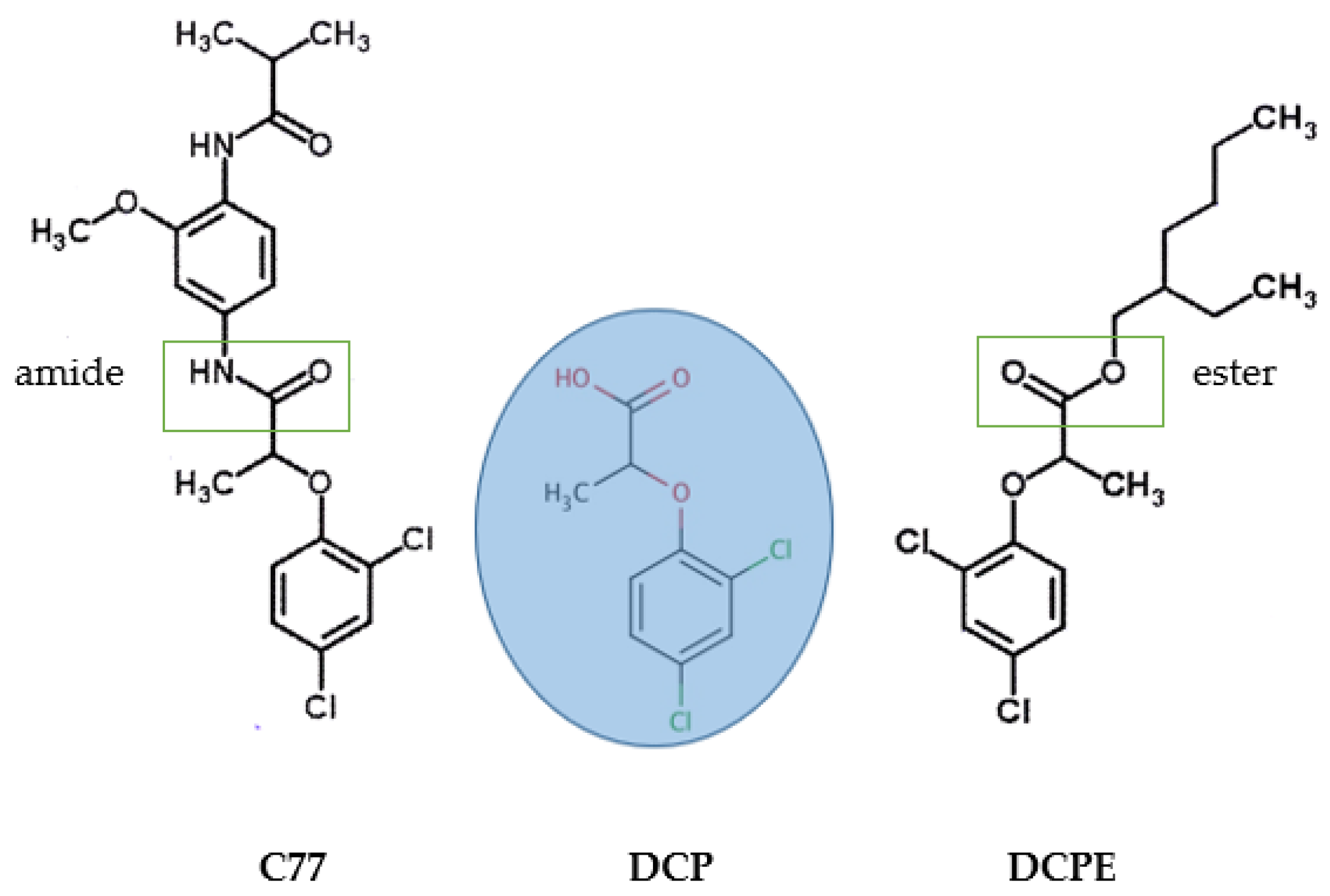

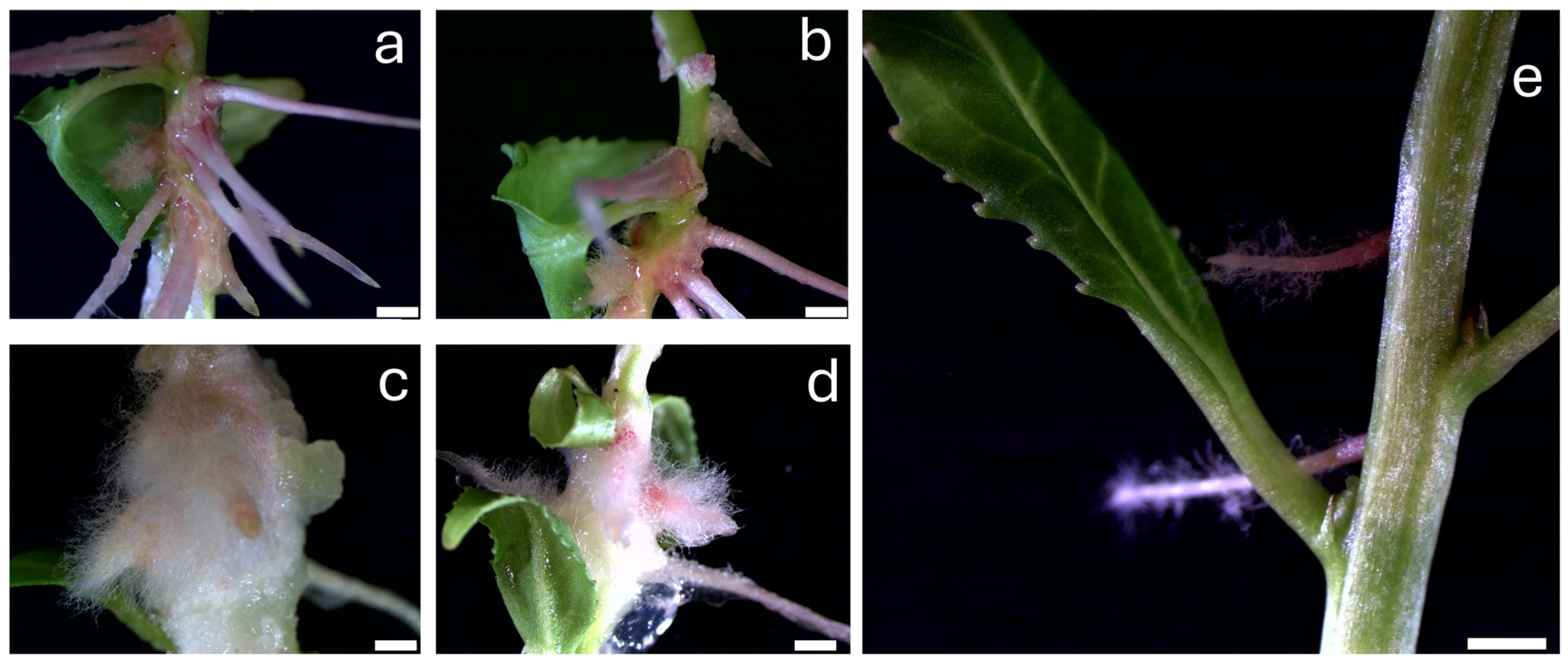
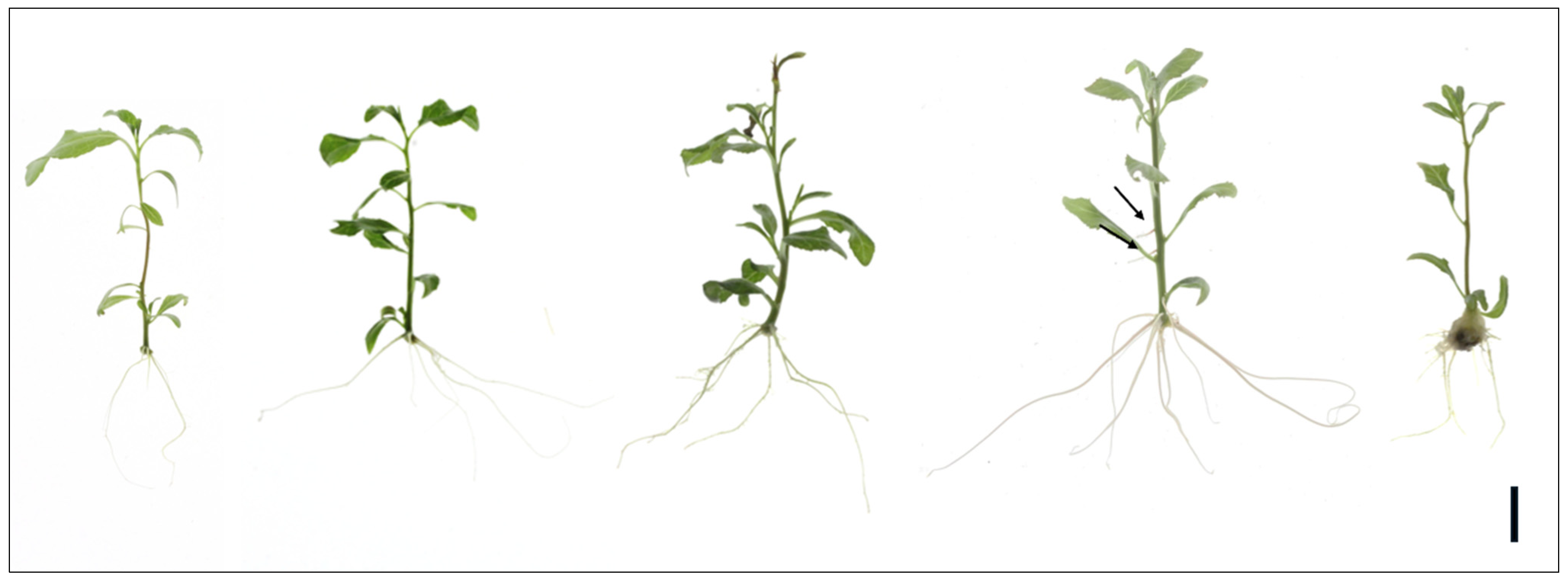
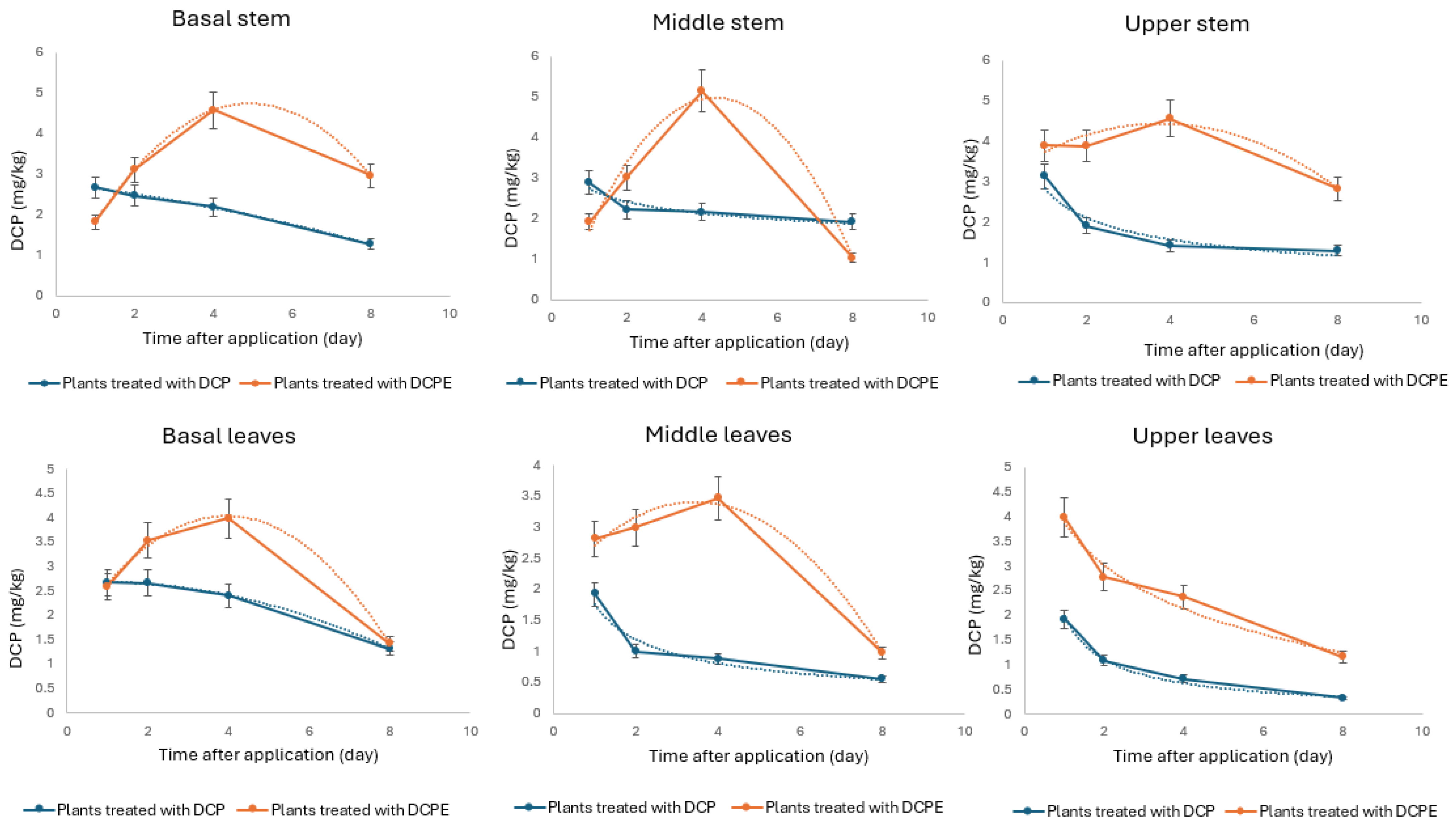
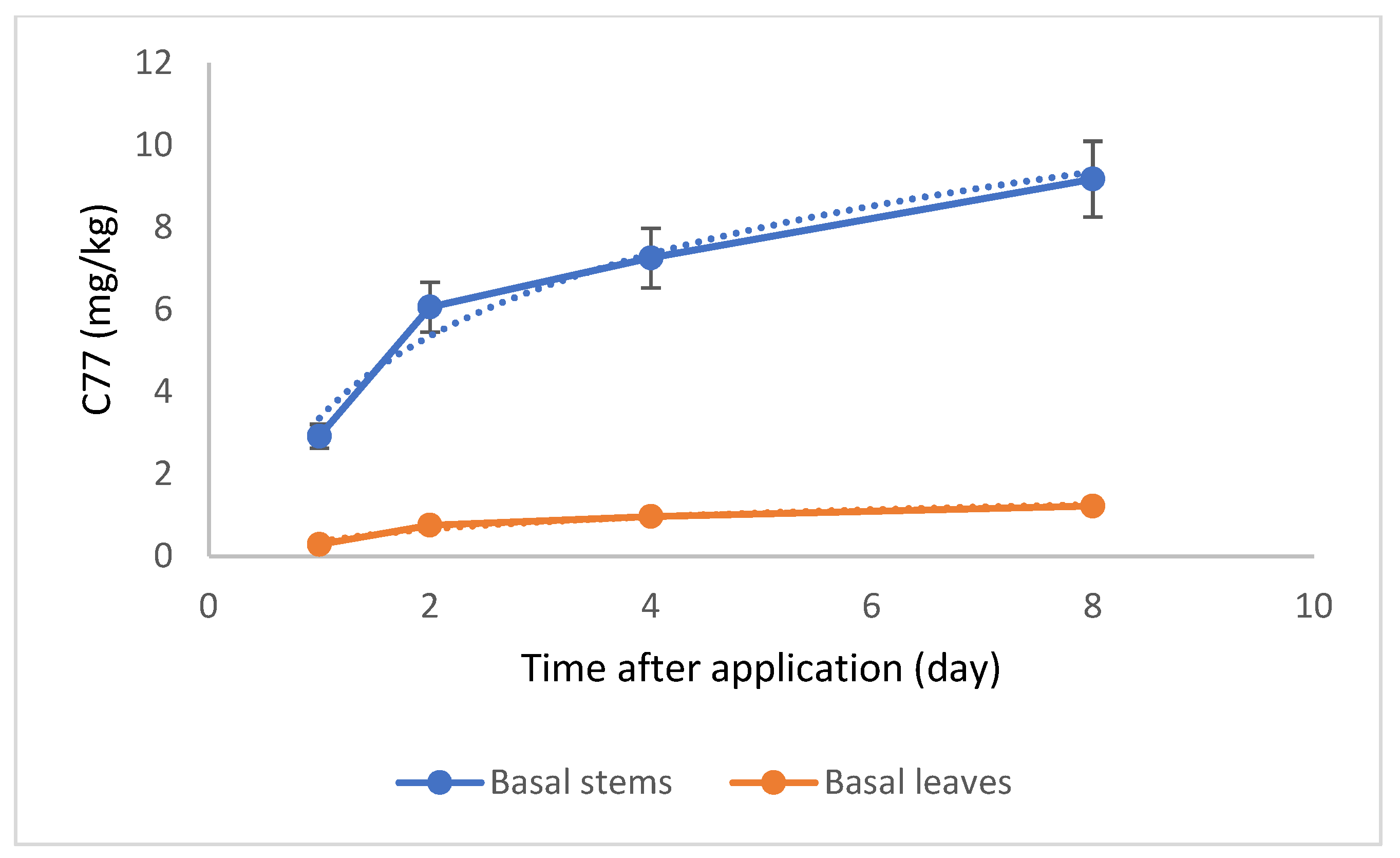
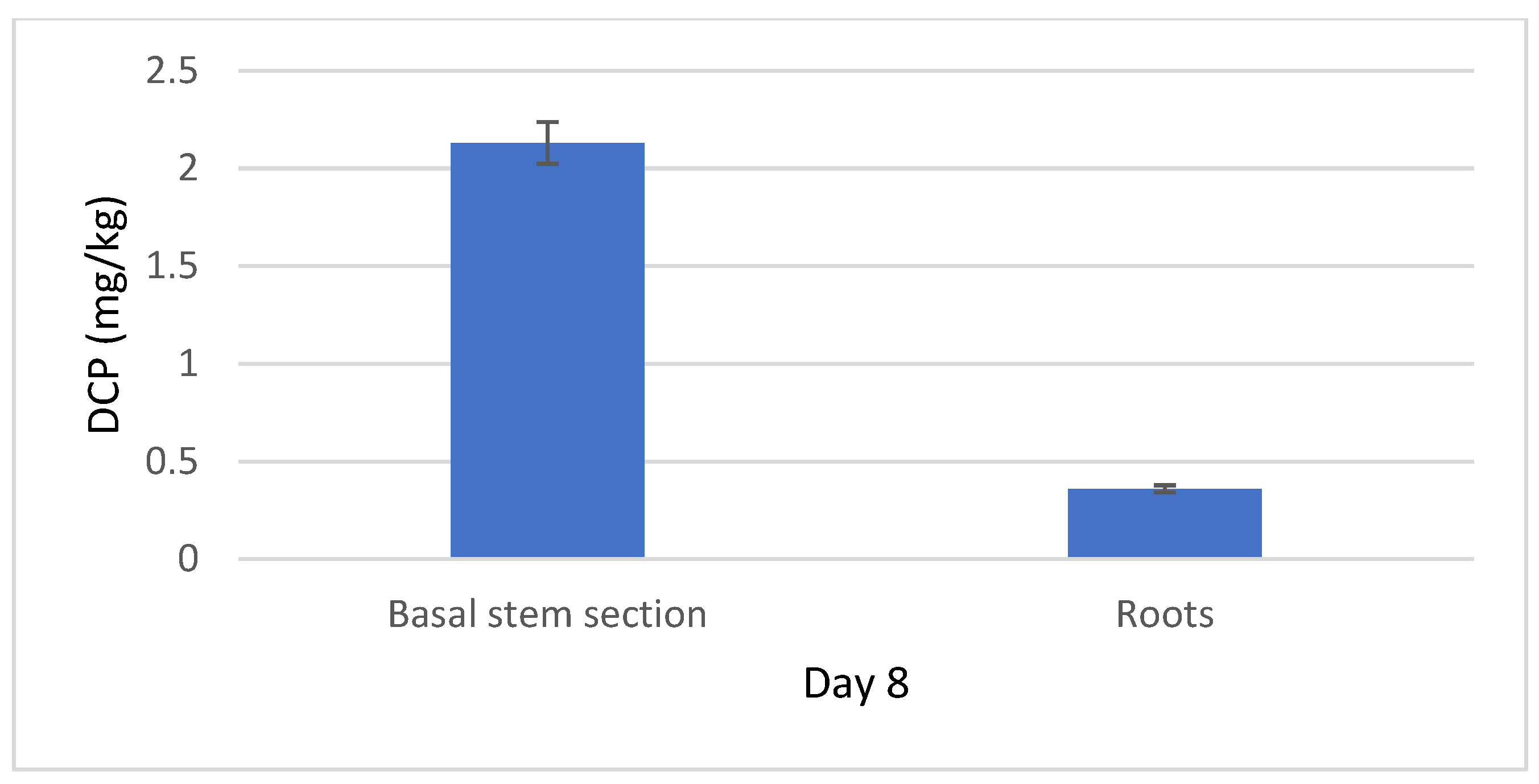
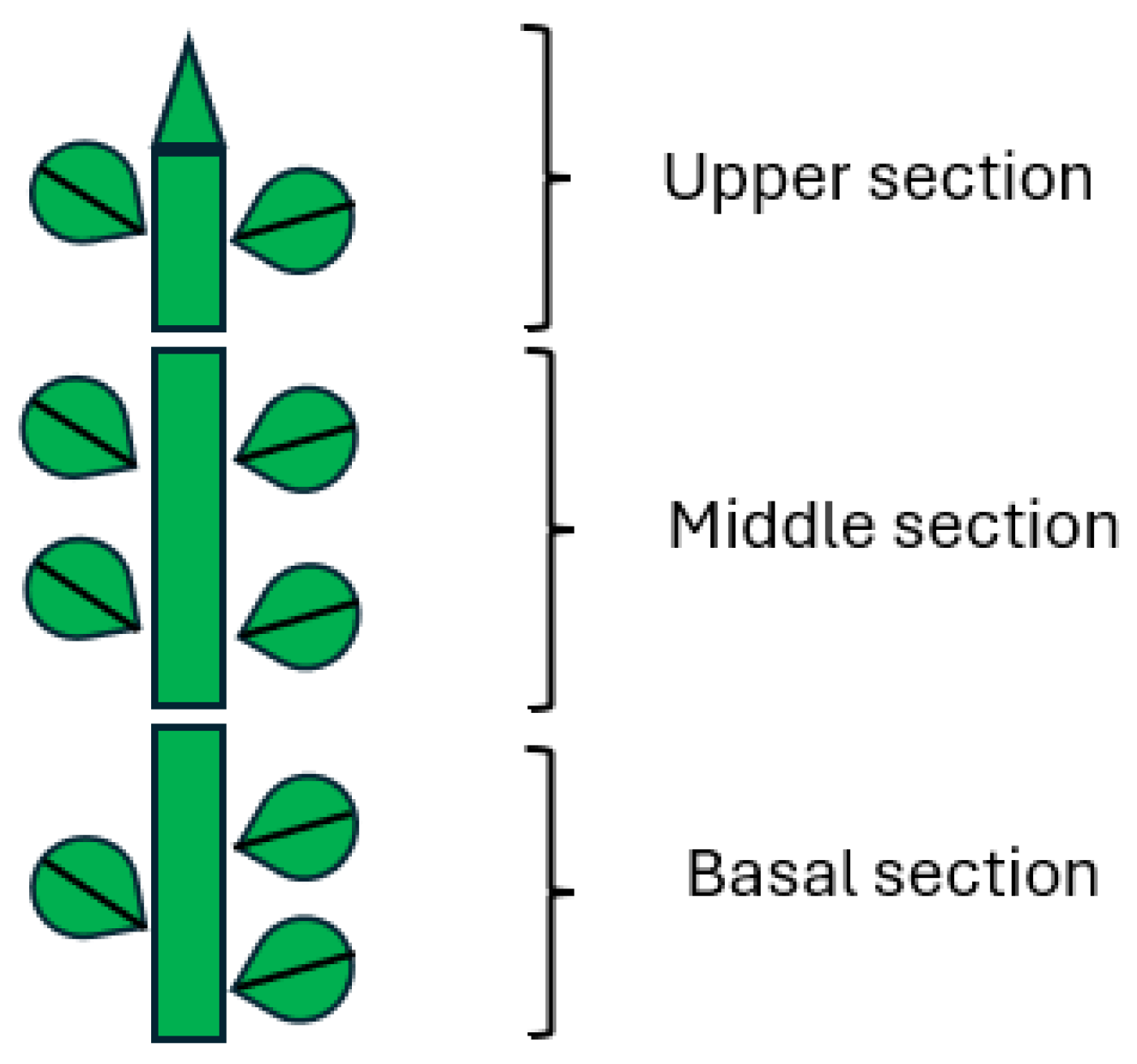
| Auxin Prodrug Treatments | Adventitious Root Number | Lateral Root Number | Average Adventitious Root Length (cm) | Root Weight (mg) | Callus Weight (mg) |
|---|---|---|---|---|---|
| Control | 4.67 ± 0.34 a | 7.04 ± 0.67 b | 2.31 ± 0.09 a | 3.41 ± 0.85 a | 0 ± 0 a |
| 0.01 µM DCPE | 6.2 ± 0.39 b | 5.22 ± 0.66 a | 3.28 ± 1.8 b | 5.46 ± 0.64 b | 0 ± 0 a |
| 0.1 µM DCPE | 15.83 ± 0.7 d | 22.35 ± 1.2 d | 1.72 ± 0.1 c | 5.21 ± 0.79 b | 0.38 ± 0.034 c |
| 0.01 µM DCP | 4.3 ± 0.28 a | 5.15 ± 0.5 a | 2.79 ± 0.18 ab | 7.6 ± 0.77 c | 0 ± 0 a |
| 0.1 µM DCP | 13.7 ± 0.68 c | 18.44 ± 1.02 c | 1.43 ± 0.09 c | 2.89 ± 0.32 a | 0.23 ± 0.02 b |
| Auxin Prodrug Treatments | Adventitious Root Number | Lateral Root Number | Average Adventitious Root Length (cm) | Root Weight (mg) | Callus Weight (mg) |
|---|---|---|---|---|---|
| Control | 4.67 ± 0.34 a | 7.04 ± 0.67 a | 2.31 ± 0.09 b | 3.41 ± 0.85 a | 0 ± 0 a |
| 0.01 µM C77 | 6 ± 0.26 b | 19.02 ± 0.85 c | 3.51 ± 0.19 d | 5.46 ± 0.64 b | 0 ± 0 a |
| 0.1 µM C77 | 6.2 ± 0.28 b | 23.11 ± 0.63 d | 3.19 ± 0.21 cd | 5.21 ± 0.79 b | 0 ± 0 a |
| 1 µM C77 | 10.72 ± 0.3 c | 10.19 ± 0.73 b | 2.59 ± 0.13 bc | 7.6 ± 0.77 c | 0 ± 0 a |
| 10 µM C77 | 10.89 ± 0.41 c | 13.09 ± 0.95 b | 1.03 ± 0.07 a | 2.89 ± 0.32 a | 38.11 ± 2.35 b |
Disclaimer/Publisher’s Note: The statements, opinions and data contained in all publications are solely those of the individual author(s) and contributor(s) and not of MDPI and/or the editor(s). MDPI and/or the editor(s) disclaim responsibility for any injury to people or property resulting from any ideas, methods, instructions or products referred to in the content. |
© 2025 by the authors. Licensee MDPI, Basel, Switzerland. This article is an open access article distributed under the terms and conditions of the Creative Commons Attribution (CC BY) license (https://creativecommons.org/licenses/by/4.0/).
Share and Cite
Darouez, H.; Werbrouck, S.P.O. In Vitro Rooting of Poplar: Effects and Metabolism of Dichlorprop Auxin Ester Prodrugs. Plants 2025, 14, 108. https://doi.org/10.3390/plants14010108
Darouez H, Werbrouck SPO. In Vitro Rooting of Poplar: Effects and Metabolism of Dichlorprop Auxin Ester Prodrugs. Plants. 2025; 14(1):108. https://doi.org/10.3390/plants14010108
Chicago/Turabian StyleDarouez, Hajer, and Stefaan P. O. Werbrouck. 2025. "In Vitro Rooting of Poplar: Effects and Metabolism of Dichlorprop Auxin Ester Prodrugs" Plants 14, no. 1: 108. https://doi.org/10.3390/plants14010108
APA StyleDarouez, H., & Werbrouck, S. P. O. (2025). In Vitro Rooting of Poplar: Effects and Metabolism of Dichlorprop Auxin Ester Prodrugs. Plants, 14(1), 108. https://doi.org/10.3390/plants14010108








